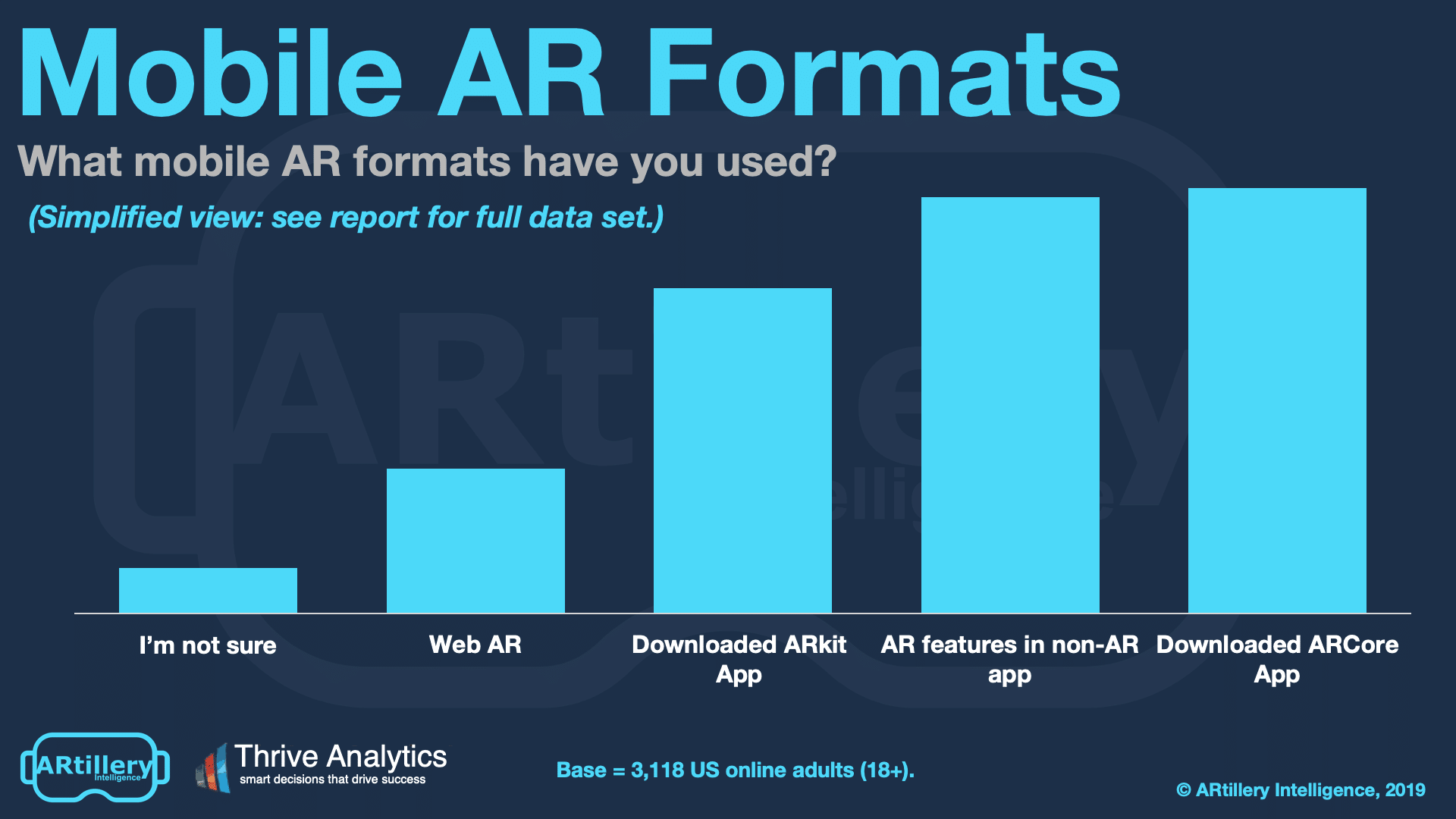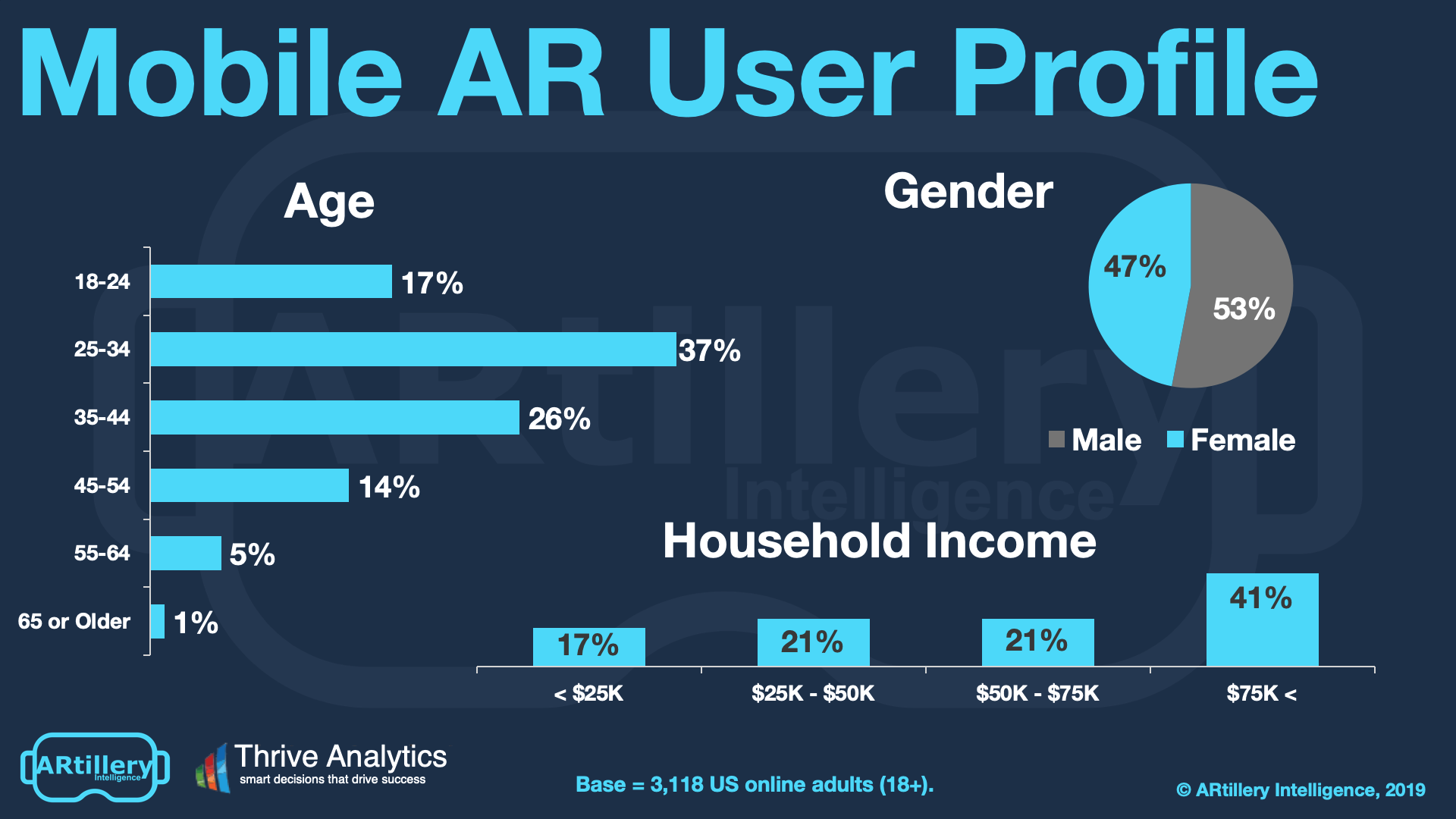
This post is adapted from ARtillery Intelligence’s latest report, Mobile AR Usage & Consumer Attitudes. It includes some of its data and takeaways. More can be previewed here and subscribe for the full report.
How do consumers feel about mobile AR? Who’s using it? How often? And what do they want to see next? More importantly, what are non-users’ reasons for disinterest? And how can app developers and anyone else building mobile AR apps optimize product strategies accordingly?
These are the questions we set out to answer. Working closely with Thrive Analytics, ARtillery Intelligence wrote questions to be presented to more than 3000 U.S. adults. The results are in and analyzed in the latest ARtillery Intelligence report. Today we dive into top AR formats.
But to first add context to survey findings throughout this report, who’s answering the questions? It includes more than 3000 U.S. adults. Going deeper into demographics and psychographics, AR users break down as shown below. More detail and segmentation are available on request.
As the data show, the segment of AR users spans a wide range of U.S. adult consumers. Gender breaks down fairly evenly, while age and income levels skew towards attractive demographic groups. That includes buying-empowered age groups (25-34), and high-income homes ($75K+).
Usage: The “How Many?”
Starting our analysis at the top, what’s the overall penetration and adoption of mobile AR among consumers? Survey results indicate that it currently stands at 22 percent of the U.S. population. This isn’t surprising, however it’s slightly greater than anecdotal evidence would suggest.
This is a positive sign for the health of consumer-based mobile AR: These figures represent a combination of healthy adoption (considering the early stage) and lots of room to grow. We expect usage levels to accelerate quickly in future survey waves, similar to early smartphone adoption.

Formats: The “How?”
Drilling down, how are AR users consuming the experience, and in what formats is it being delivered? Given that Apple and Google’s respective AR developer kits (ARkit and ARCore) have “democratized” and popularized mobile AR, they’re the leading delivery channels in early days.
Specifically, 47 percent of AR users report using ARCore apps while 36 percent report ARkit. This is somewhat surprising due to these platforms’ market shares. Though ARCore will eventually reach the larger Google Android universe, ARkit has an early lead of AR-compatible iPhones.
But more interesting is what lies beyond these two platforms. As we’ve examined, apps might not be the best vessel for AR, given download friction and other dynamics. So we’re bullish on two other formats represented in these results – one that’s already excelling and one that’s emerging.
The former is what we call “AR-as-a-feature.” This lowers adoption barriers by planting AR functionality right within already-well traveled apps. This gives AR a sort of “training wheels” approach, before it’s popular enough to compel its own dedicated apps and destinations.

In fact, the most popular flavors of AR date are Pokémon Go and Snapchat Lenses. Both of these fall into the category of AR-as-a-feature. They are or include AR features within broadly-defined (non-AR) apps. They’ve also interestingly received the most AR traction without ever saying “AR.”
The second area we’re bullish on is Web AR. These are AR experiences delivered in the mobile browser. Because AR is so nascent, there’s less incentive and proven value for users to endure the friction of app downloads. Web AR also avoids fragmented platforms and compatibility issues.
Web AR still has some quality and capability deficiencies compared to apps, but that’s quickly changing due to the work of innovative startups like 8th Wall. ARtillery Intelligence will circle back to this topic in an upcoming report, but for now these survey results are promising for web AR.
See more details about this report or continue reading here.
For deeper XR data and intelligence, join ARtillery PRO and subscribe to the free AR Insider Weekly newsletter.
Disclosure: AR Insider has no financial stake in the companies mentioned in this post, nor received payment for its production. Disclosure and ethics policy can be seen here.

